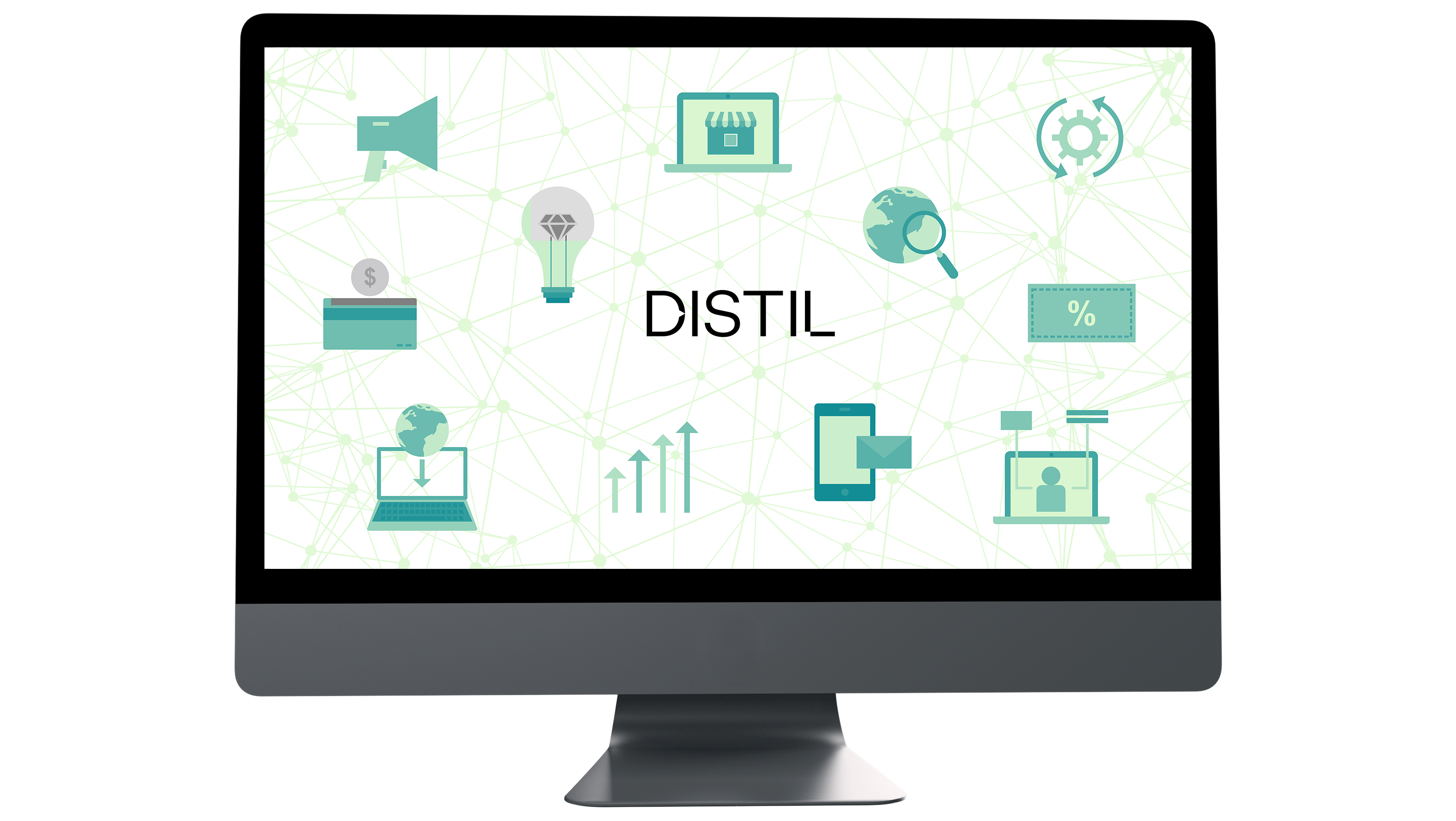
In simple terms, digital marketing is everything that you as a business do to increase brand awareness and sales by using, you guessed it, your digital channels. Your digital channels include your social media pages, your website, digital advertising and online listings.
Whilst digital marketing is everything you do electronically or online, traditional marketing refers to print ads, flyers, phone communication, TV & radio ads or in-person marketing (we’ve all been stopped by a person on the street at least once). Depending on the nature of your business, you may want to use a combination of digital and traditional marketing but in today’s climate, all businesses should use digital marketing in one way or another.
The main benefits of digital marketing are that it is often cheaper, and you have control over the spend, and that you have the ability to measure the results real time. The results of traditional marketing can be difficult to measure as you, for example, don’t have the insights on how many people saw your ad in a print magazine. In addition, traditional marketing can be quite pricey and, let’s face it, as a small business owner your marketing budget is likely to be limited. Ultimately, however, what type of marketing and what channels your business use come down to your goals and your audience.
When we speak about digital marketing channels, we refer to three types of channels: owned, earned and paid channels. Your owned channels include your website, your social media accounts, your email database, online listings and SEO while your paid channels refer to advertising. Your earned channels on the other hand are when people write reviews online, when an online publication writes about you or when a person or brand shares your content or mentions you. You can’t control your earned channels but you can influence them with your marketing efforts and the way you run your business.
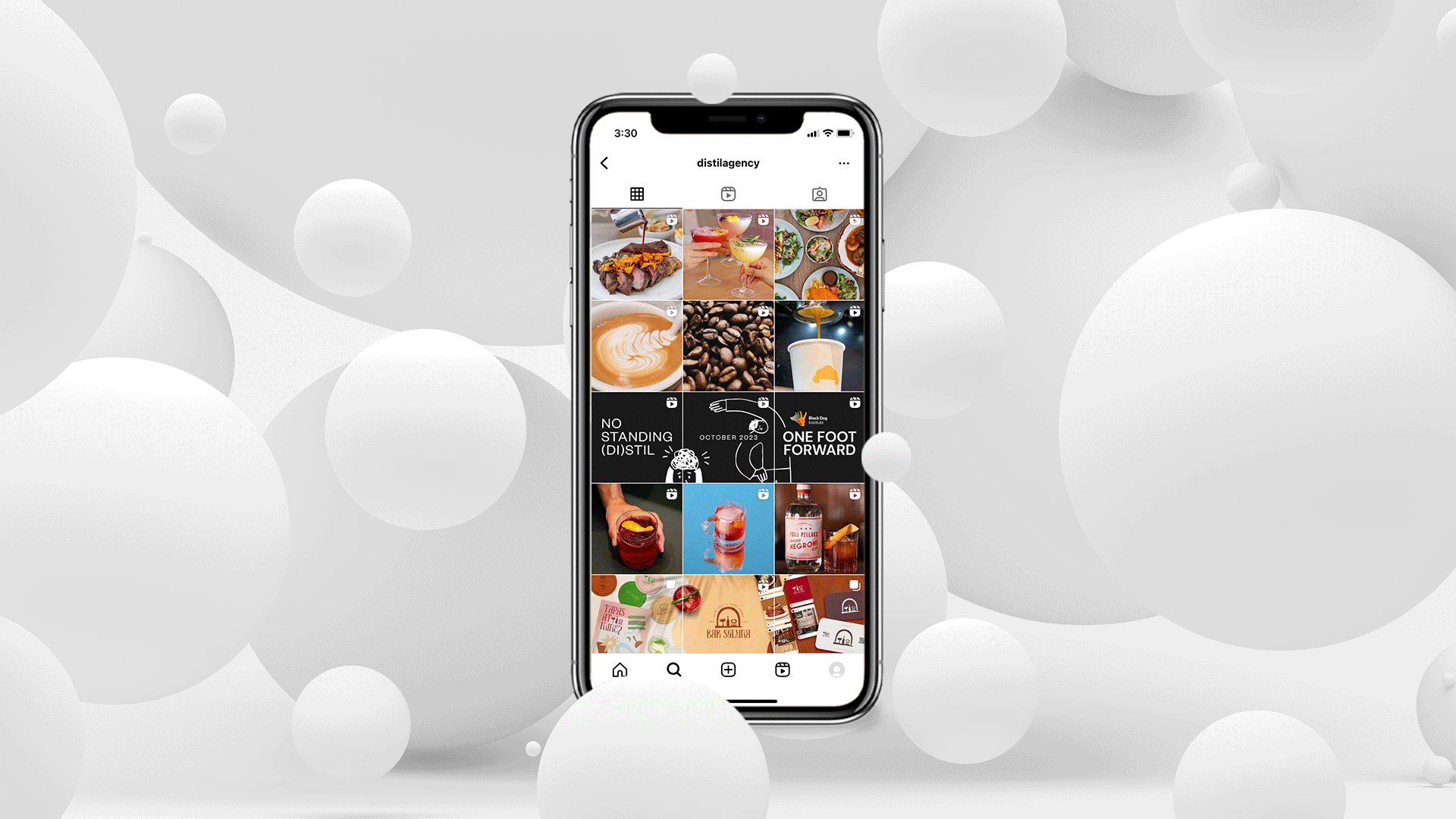
Your owned channels refer to channels that your business created and as such have full access to. You decide yourself how you portray your brand, what content you share and when you share it on these channels. Your owned channels are the cornerstone of your marketing and it’s vital that you spend time and effort on building them. The downside is that it can be time consuming to manage your channels and difficult to see results without a strategy.
Your website is one of your most important channels and is often one of the first points of contact with your customers. Think of your website (and your other digital channels) as a billboard and ask yourself the question – if this was a billboard that I paid for, what would I say and how would I say it? Whatever the answers are, they should be applied on your website and remember, you may just have one shot to make a good impression so when you build or update your website, it is important that you consider the following:
It is important that you always stick to your business’ branding and with branding we’re not just referring to your logo but to your menus, the in-venue collateral, your tone of voice and even the atmosphere you have in venue. Ultimately, you want the website to communicate your brand story and what people can expect when they visit your venue. Think about your brand, what it is, how you want it to be perceived and how it is perceived before you design your website.
Have you ever been to a website that has a blurry photo of food, very obviously taken by a mobile phone with poor lightning, and thought to yourself - I must try this place? You probably haven’t and neither have other people. It may seem like a big cost but we can’t stress the importance of professional photography enough. Invest in quality images for your website and ensure that your website is visually appealing and why not try and combine your photos with videography. However, ensure the photos are an accurate representation of what the product looks like in real life. We’ve all seen an Instagram vs Reality photo of a Big Mac and it isn't pretty.
The text on your website is just as important as your imagery as it helps with SEO and with telling your brand story. It’s important that you write the text aligned with your brand’s voice and that it is written to your targeted audience. Don’t forget to check for spelling mistakes!
Always make sure that the information on your website is correct. This includes everything from your contact details and opening hours to menus and specials. Not only will it annoy your customers if the information is incorrect but it also hurts your SEO.
It is important that you think about your website from your customers’ experience. Is it responsive? Is the menu easy to find? Is it easy to contact you or to make a booking? People have little patience and if it’s not working or they can’t find what they are looking for, chances are they’ll move on.
The final point to consider is your SEO (Search Engine Optimisation). In simple terms, SEO is the process of improving your website’s performance in organic search engine results. Search Engines has ‘crawlers’ that go through websites and gather all the content they can find on the internet in order to build an index. The index is fed through an algorithm that will try to match the data available with your search query. Basically, you want to make sure that your website shows up when people search for key words related to your products and services.
There are a range of steps to follow to improve on-page SEO but a good start is to go through the below checklist:
As of January 2024, 5.04 billion people use social media, that is more than half the world. While your website previously was the very first point of contact with a customer, many people now utilise social media first. 90% of Instagram’s users follow at least one business, and 62.4% say they use so Instagram to find new products or services. Needless to say, social media is an effective and cost-efficient tool to target new and current customers and should be utilised by all businesses. By combining photos, GIFs and videos with text and links to your website, you can effectively communicate your offering and for best results, your social media accounts should be updated frequently. Social media is also regarded as the new SEO, as Google reads social media websites for data just as it does for any other website.
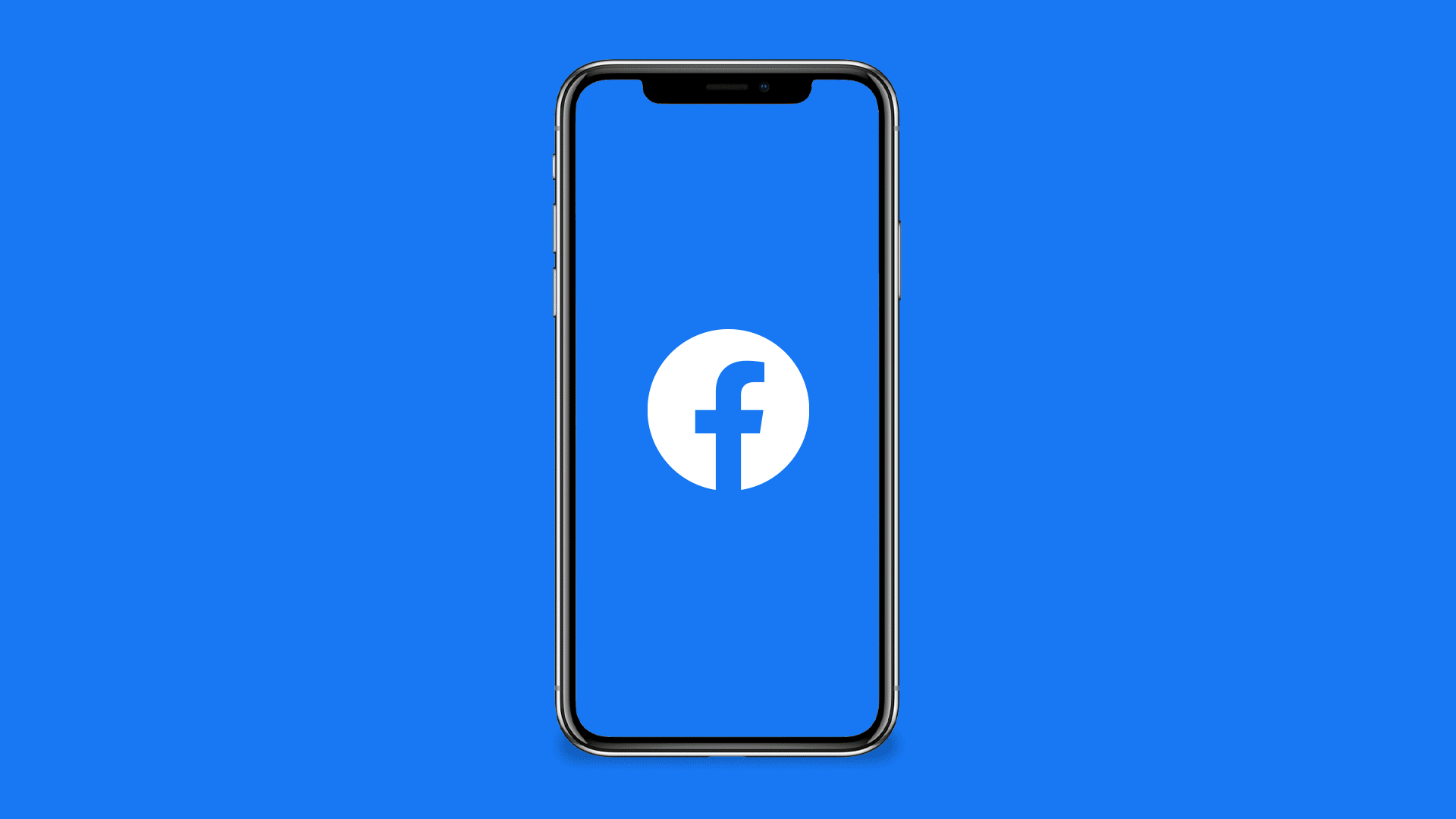
Read more about the benefits of Social Media.
Facebook is the biggest social network in the world, the world’s third most popular app. Since launching in 2006, Facebook has provided businesses with a way to easily reach existing and potential customers and it comes as no surprise that there are over 90 million business pages on Facebook.
Facebook is a great tool to communicate your business’ offering and upcoming events and you should regularly share content on your Facebook page. There are a number of different post types available and you can choose to post immediately or schedule posts for later, making it easier to maintain consistent posting.
As a business, you can advertise on Facebook and it’s an important tool to connect with your current and potential customers. The Facebook algorithm can make it difficult for you to organically reach your audience but with Facebook ads you can get your content in front of not only your audience but the people who are most likely to be interested in your business.
Learn more about using Facebook for your business in our guide HERE.
Instagram is now the most popular app in the world, and has over 2 billion active users every month. It has proven to be a powerful marketing tool and if your business isn’t on Instagram, you might be missing out on valuable customers. Before you get started using Instagram for your business, you need to make sure you have a business profile to get access to tools and functionality that a personal profile doesn’t have, as analytics, advertising and more.
Much like Facebook, Instagram is a great platform to communicate your brand and offering to your audience. You should post frequently on your feed and stories and as Instagram is more visually oriented, you should aim to create high quality, engaging content. We also recommend planning your feed in a way that is visually appealing and consistent with your brand. Find out more on scheduling Instagram posts HERE.
One of the most trending tools in today's Instagram landscape is reels. Instagram Reels are short-form video content that can be up to 90 seconds long. These videos are highly edited and shot in vertical dimensions for an immersive, full-screen viewing experience. Instagram made the move to prioritise video content in 2020, essentially to rival its competitor TikTok.
Learn more about how you can use Instagram for your business in our guide HERE.
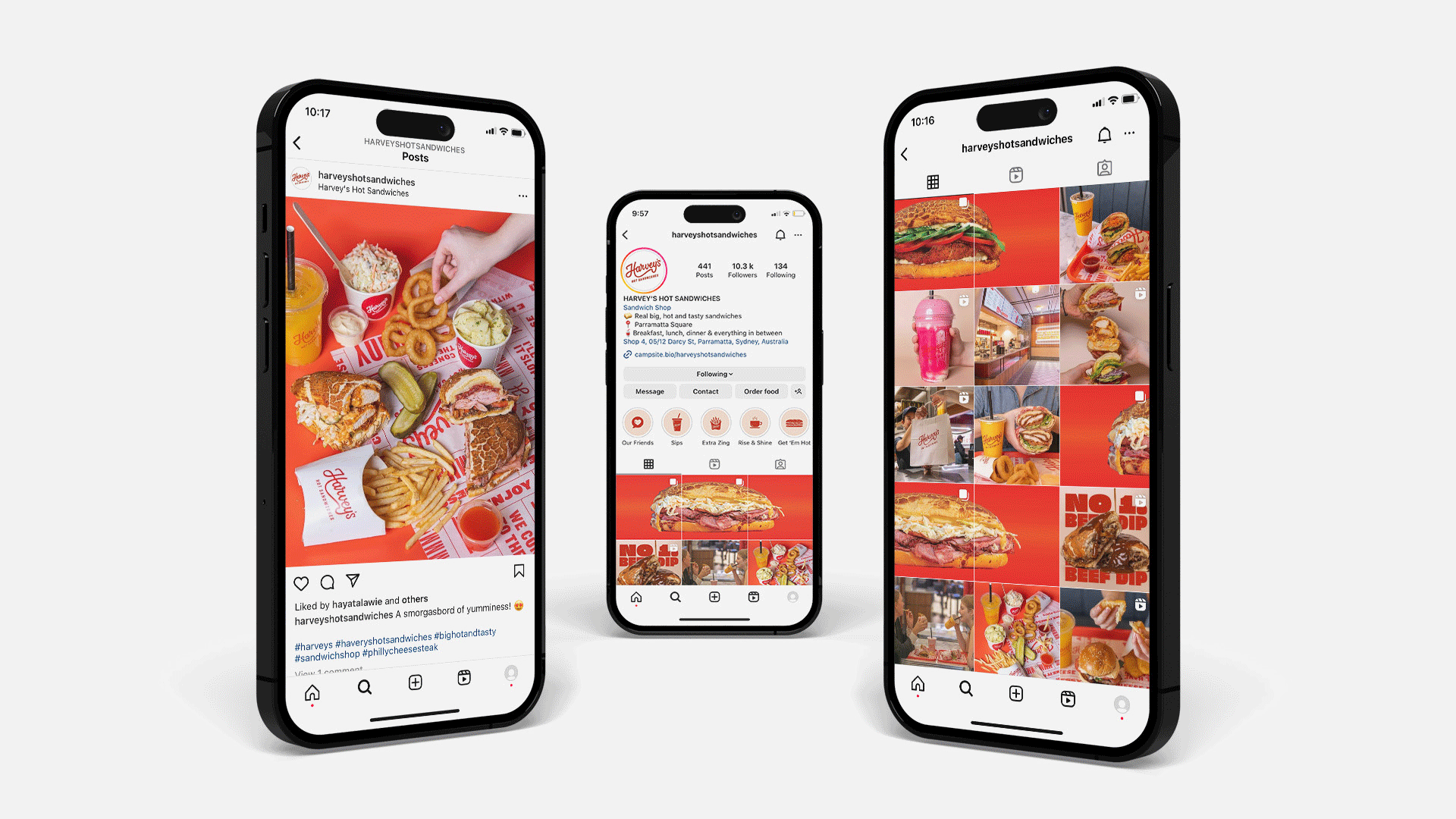
Did you know LinkedIn has over 774 million users across the globe? This metric alone makes the platform one of the top social networks today. With new social networks sprouting up constantly, LinkedIn is a platform that's often under-utilised. LinkedIn can be a powerful addition to your social media content strategy.
Whilst LinkedIn is popular amongst big brands, particularly to strengthen employer value proposition (EVP) and brand reputation, it isn't the first platform for marketing for hospitality venues. It is certainly worthwhile to set up a business page for recruitment purposes and to further strengthen your online presence.
LinkedIn is the platform you use to network with similar businesses, find likeminded employees, advertise to corporates and businesses for B2B purposes and more.
Is it the right fit for your business? Learn more HERE.
As of Q3 2023, Snapchat has 406 million active users worldwide daily. It is undoubtedly a popular platform, especially among millennials and Generation Z. So, is Snapchat suitable for you?
Again, the answer depends on your audience, your brand and what you are trying to achieve. If you are operating a nightclub and are targeting a younger demographic, perhaps Snapchat is a great platform for you but if you are targeting a slightly older demographic, it is probably not worth your time. Don’t use Snapchat just because you think that you should but let your target audience and brand inform the decision. If you do decide to use it, let your audience know that you exist on the platform and make sure you keep the content authentic, casual and fun.
Since launching in 2006, Twitter has been a powerful social networking tool and has widely been used by people, celebrities, global brands and news magazines etc. There are over 550 million monthly users on X and there are no doubts that you can reach a large audience on the platform.
In our opinion however, it is not worth the time for hospitality venues to be on X (unless they are a large, household name like McDonalds) and with the rise of Instagram, which is a lot more visually appealing, it’s hard to see the benefits. That being said, X can be a good platform for a reputable chef or bartender as a complementary platform to share news and recipes.
Pinterest has 445 million monthly users. While Pinterest certainly is a great platform to find inspiration and share content that links back to your website, it really is only of value if you upload content with popular keywords, if you frequently share content, perhaps recipes, on your page or if you have an e-commerce for cookbooks, merch or similar.
If you are going to use Pinterest for your business, it’s essential that you always include a link to your website to drive traffic.
TikTok today is massive, especially in the younger audiences. It is a video sharing app with over 1 BILLION monthly users. Impressive, right?
TikTok / Douyin was initially launched into China’s App market in September 2016 by parent company Bytedance; it racked up 100 million users in a year. TikTok, the international version, had a release date in September 2017 following the acquisition of a video-sharing startup, Musical.ly.
While it's impossible to cover every one of TikTok's categories of contents, some of the top types of content are comedic skits, lip-synching, memes and hashtag challenges.
TikTok can be a very useful addition to your social media strategy, particularly if you wish to reach Gen-Z and millennials. However, we only recommend being on the platform if you have the resources for content creation, as TikTok is very heavily based in creating engaging videos for your audience, and being up to date in what's trending.
Learn more about TikTok in our guide HERE.
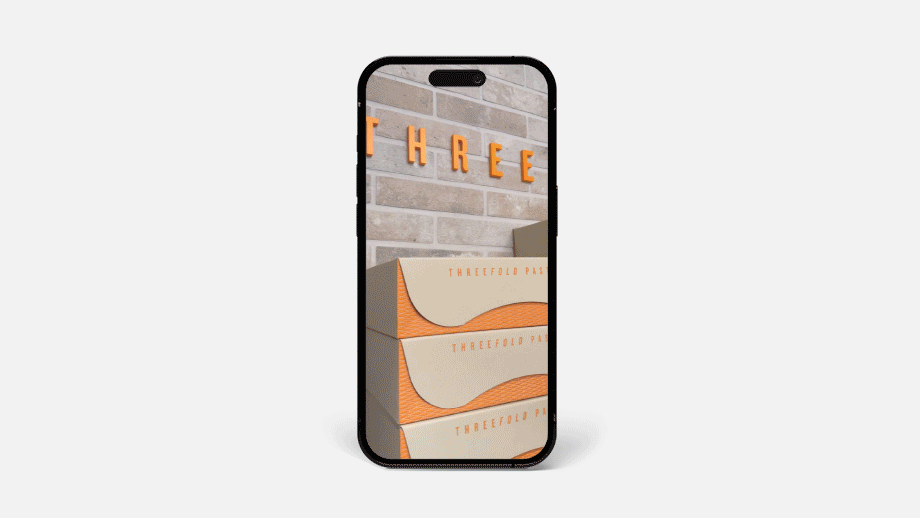
Content creation by Distil for Threefold Pastry
Email Direct Marketing (EDM) can be an effective tool to communicate with your existing customers. The people on your mailing list have voluntarily signed up to receive emails (if you’re following the privacy laws that is) and are what we consider “hot leads”. They are likely to be interested in new offerings and events and you should actively work on building your database.
When you send out an EDM there are a few things to think about:
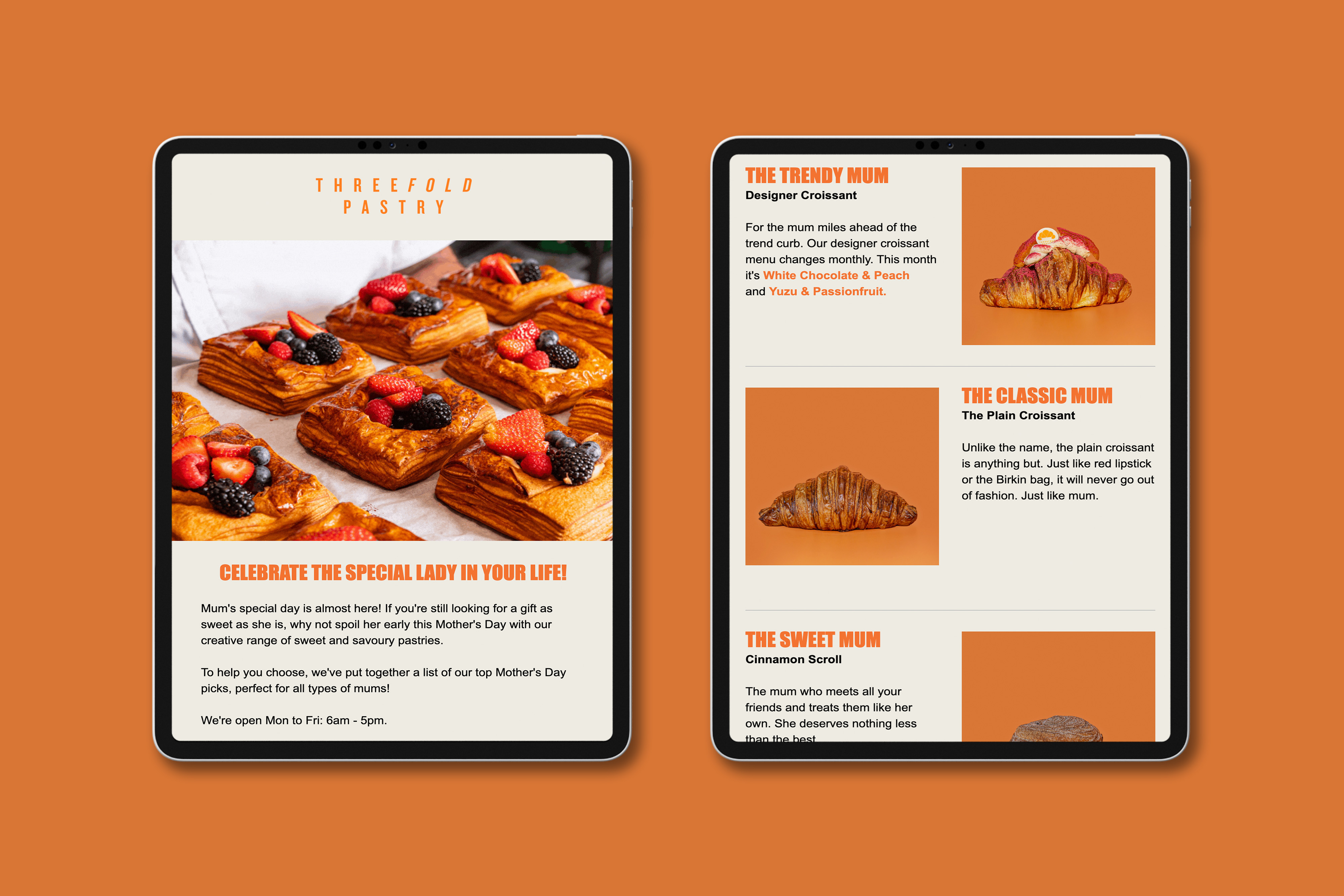
EDM for Threefold Pastry by Distil
A good rule for your email marketing is to send one email per month. You don’t want to spam people, but you want to make sure you are at the front of their minds. However, if you don’t have anything new to talk about, it may be better to not send one.
Check out the 10 best EDM softwares for 2024 HERE.
Everything you do online is part of your digital marketing efforts and includes your listings on various platforms. Online listings are a great tool for new customers to find you and the list of different online listings available for businesses is endless. Where you choose to list your venue largely depends on your business goals and your audience but we would recommend that you claim all listings associated with your business, and at a minimum the below mentioned ones. That way, you can ensure the information is correct and can use the platforms to communicate your brand.
Your Google My Business listing is a free profile offered by Google that allows you to connect with current and potential customers across Google Search and Maps. Your Google listing can appear via Direct searches (a customer directly search for your business name or address), Discovery searches (a customer search for a category, product or service that you offer and your listing appears) and Branded searches (a customer search for your brand or a brand related to your business).
As a business, you should claim your listing in order to control the information and always make sure that it’s up to date. You can add photos and videos and add your contact details and other useful information and, similarly to Facebook, you can also post photos and offers to your profile. By sharing relevant content, you are telling Google that your business is legit which will help with authority. Basically, the more you legitimise your business, the higher Google will rank your listing and the higher you rank, the higher you appear on Google search.
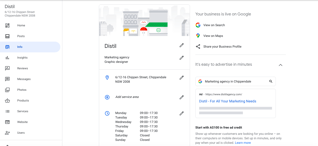
TripAdvisor is best explained as an online guestbook where people share their experiences from holidays and restaurants or bars. Your venue’s TripAdvisor listing is a great platform for potential customers to find you and it’s important that you keep the information up to date. In addition, TripAdvisor offers businesses to advertise on the site. By promoting your restaurant in exclusive sponsored placements, the ads can drive traffic to your listing. The ads are targeted to a specific audience of diners searching for a place to eat in your area and are particularly helpful if you don’t appear in the top venues. There are three options available for ads; $2.07 per day, $2.76 per day and $3.45 per day and during peak tourist season, we recommend that you allocate a budget for TripAdvisor Ads to ensure your venue listing is visible for users looking for options.
If your restaurant offers and relies on takeaway, it might be worth considering being on food delivery platforms such as UberEats, DoorDash, EASI and Menulog. These have seen a major increase in usage since the COVID-19 pandemic.
In 2023, a survey conducted among Australian consumers about online food delivery bookings by brand found that 67 percent of respondents had used Uber Eats in the past 12 months to order food. Menulog took second place, with 47 percent of those surveyed using the food delivery platform.
These add to your digital marketing strategy as well, due to the increased exposure to those in your delivery radius who are not looking to head out. Note that this may not be the best route if you are focused on having foot traffic at your venue, especially if your venue is a pub.
As the name suggests, your paid channels are the elements of your marketing strategy that you pay for. If executed correctly, it’s a good tactic to quickly promote your content to a wider audience and to help kickstart your marketing. The obvious downside of paid channels is that it can quickly get expensive and you won’t necessarily reach the right people.
Over the last few years, social media has increasingly become a pay-to-play game as the algorithms favour content from friends and family over businesses, restricting the organic reach. Social media advertising should be part of every brand’s marketing strategy as without money behind your content, not even your followers are guaranteed to see what you share. Social media is an important tool for businesses to connect with their audience and with Facebook and Instagram ads, you can get your content in front of not only your audience but the people who are most likely to be interested in your business.
For those of you who don’t know, Instagram is owned by Meta so moving forward, when we refer to Meta advertising, Instagram is included.
Via Meta you can choose to boost an existing post or set up what we call a backend campaign or ads. Depending on the goals of your business, you may find that boosting posts are sufficient to reach your objective. Other times, ads are required.
A boosted post is a post published on your business page that you add money to in order to promote it to a targeted audience. This is the simplest way to advertise and you boost the post directly from your business page, and as such boosted posts don’t require that you have Ads Manager. When you boost a post, you select your audience, a call to action, your budget and the duration of your campaign.
A Facebook Ad on the other hand, can only be created through Ads Manager and offer more advanced solutions than boosted posts. Generally speaking, if you want engagement or to increase brand awareness, boosting a post is a great way to increase the visibility but to create more advanced campaigns, Ads Manager is preferred.
Learn more about Facebook advertising in our step-by-step guide.
TikTok shared that 81% of TikTok users who made a Back to School purchase said the platform played a role in purchases/gifts bought.
In Australia itself, users are 1.7x times more likely to engage in ecommerce behaviours (vs. other social/video platform users that are not on TikTok).
For brands, this means higher chances of people digesting the information in your content and ads. Through videos and animations, TikTok ads are a great opportunity to directly engage with consumers in modern, creative ways, and generate awareness about your products.
Additionally, even though vertical videos might seem tricky, the full screen experience of the ads results in more attention from the audience and easier comprehension.
Learn more about TikTok Ads HERE.
Google Ads (anciently known as Google AdWords), allows you to bid for the top spot on the Google search engine results page. In short terms, you select what keywords you would like to bid on and create ads relevant to those keywords. Google Ads falls under pay-per-click (PPC), where you pay per click or per impression, and as such the cost for your Google Ads campaigns depends on the competitiveness of the keywords and the relevance of your ad. You can, however, set your maximum bid to control the spend. When Google decides what position to give your ad, they look at your ad rank (maximum bid times quality score) and if your ranking is good, you will get the top position.
Google Ads can be very effective but only if you focus on the correct keywords and produce high quality ads that generate clicks. If you don’t spend the time analysing your ads and planning keywords, you not only risk being penalised by Google but it will also quickly become costly and quite possible, a complete waste of money.
While you have full control of the two above mentioned paid channels, there are digital advertising channels where you simply pay to have your ad on a specific website. Examples include online publications such as Time Out, the Urban List and the Brag, but also more mainstream media. Advertising is part of their income and they will often sell banner and display ads across websites and emails. Banner and display ads are image-based (sometimes GIFs and videos) ads that are linked to the advertiser’s website and traditionally don’t include any text besides what you choose to include on the image. The benefits of digital advertising with third party sites are that online publications tend to be trustworthy and that it allows you to reach far beyond your own audience. The downside is that you are somewhat restricted in what you can communicate (banner ads can be quite small) and that it’s costly.

By Distil for Zeus Street Greek
In simple terms, your earned channels refer to word-of-mouth marketing and is something that you as a business can’t control directly. It includes online reviews and ratings, when someone shares your content and when someone mentions your business. Your earned channels are often considered more trustworthy than your owned and paid channels and can be very efficient in building awareness for your business. Moreover, it is free and can help with referral traffic to your website (SEO dream!) but it is outside your control and can take time, so while earned channels should play part of your strategy, it is best combined with other channels.
If paid attention to, customer reviews can be very beneficial for your business as they provide you with an opportunity to learn where you’re meeting and failing your customers’ needs. Positive reviews are probably the best kind of advertising for your business and you should have a strategy in place to encourage reviews. On the other side of the spectrum, negative reviews can be damaging for your business but if responded to, you not only have the opportunity to get a second chance but it will demonstrate to potential customers that you care and take action. Therefore, you should always monitor your online reviews and respond to them in a timely manner.
Similarly, to online reviews, social media mentions can help you build brand awareness and, ultimately, win more customers. When someone shares your content, uses the geotag or mentions your brand, your reach is amplified beyond your audience and it can help you strengthen your brand. Ideally, you want to convert your customers into ‘brand advocates’, who in turn convert people into customers. Think about it yourself, if a close friend visits a restaurant and shares a photo of a nice-looking dish with a positive statement, it’s not unlikely that you will look up at the restaurant and perhaps plan a visit. Your friend in question is the brand advocate and you are the new customer. Take it one step further, the restaurant that your friend visited, engages (like, comment or share) with their photo, leaving your friend with a positive feeling towards the brand and your friend is now likely to tell other people about their visit.
In simple terms, just as you monitor your online reviews, you should monitor your geotag, brand mentions and even your brand’s hashtags and engage with the people using it in an attempt to turn them into brand advocates.
One of the most efficient earned channels, and probably the hardest one to earn, is media coverage (if it’s positive that is). Just as paid channels, media coverage offers a unique opportunity to reach a completely new audience and a certain credibility, a ‘status’ if you wish, that you simply can’t get yourself. Media, however, doesn’t just write about anything or anyone and often the coverage is linked to an existing relationship with a PR professional. So, whilst media coverage per se doesn’t cost anything, you may also not receive any coverage without a PR agency or professional pitching on your behalf. There are obviously exceptions and you can get lucky and earn coverage, especially if you are opening a new venue, hosting a special event or have a unique offering.
For further reading on Paid, Owned and Earned Media and their differences, check out Galactic Fed's article here.
Your ‘digital brand’ is essentially the perception of your brand online via all your digital marketing channels. As an extension of your physical brand, it can be used in a number of different ways to add value to your business.
Your digital marketing assets allow you to add personality and creative ideas into your business without shifting away from your core values. While your website might show off your art style and general information about the brand, your other channels can extend these ideas and give a voice to your brand.
While this may seem obvious, it’s important that your digital brand stays within the overarching theme of your business. Too often do businesses give mixed messages by steering too far from their brand and not sticking to their core values.
As mentioned earlier, your website is your 'digital billboard' of your business and one of the most important digital assets you own. Your online brand should start here and extend to your other channels:
One of the key benefits of your digital brand is that it provides a creative space to trial and error key messaging to different audiences, without changing your key values.
A great example is Wendy's and Popeyes being playful and doing a little bit of 'innocent' roasting on X (previously Twitter).
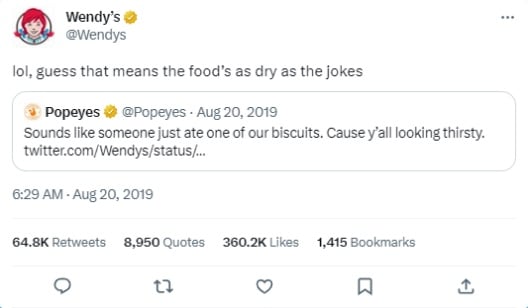
Wendy's Tweet on X
It humanises both the brands, making it look like friendly banter, and aids in creating a brand persona where customers interact with the brand as though they're a friend. It also increases the reach of both accounts as they reach the other brand's audience.
This same concept can be applied to any digital marketing strategy in a number of ways:
Want to know how we can help you and your business with our digital marketing services?